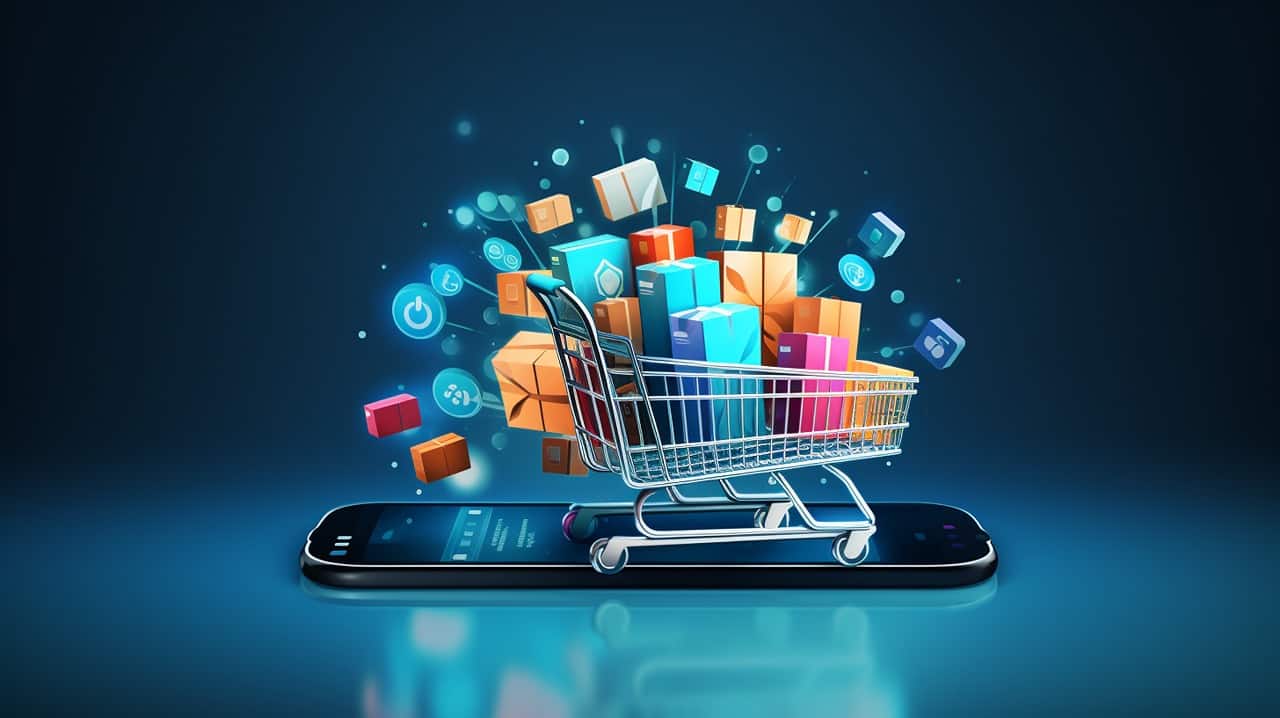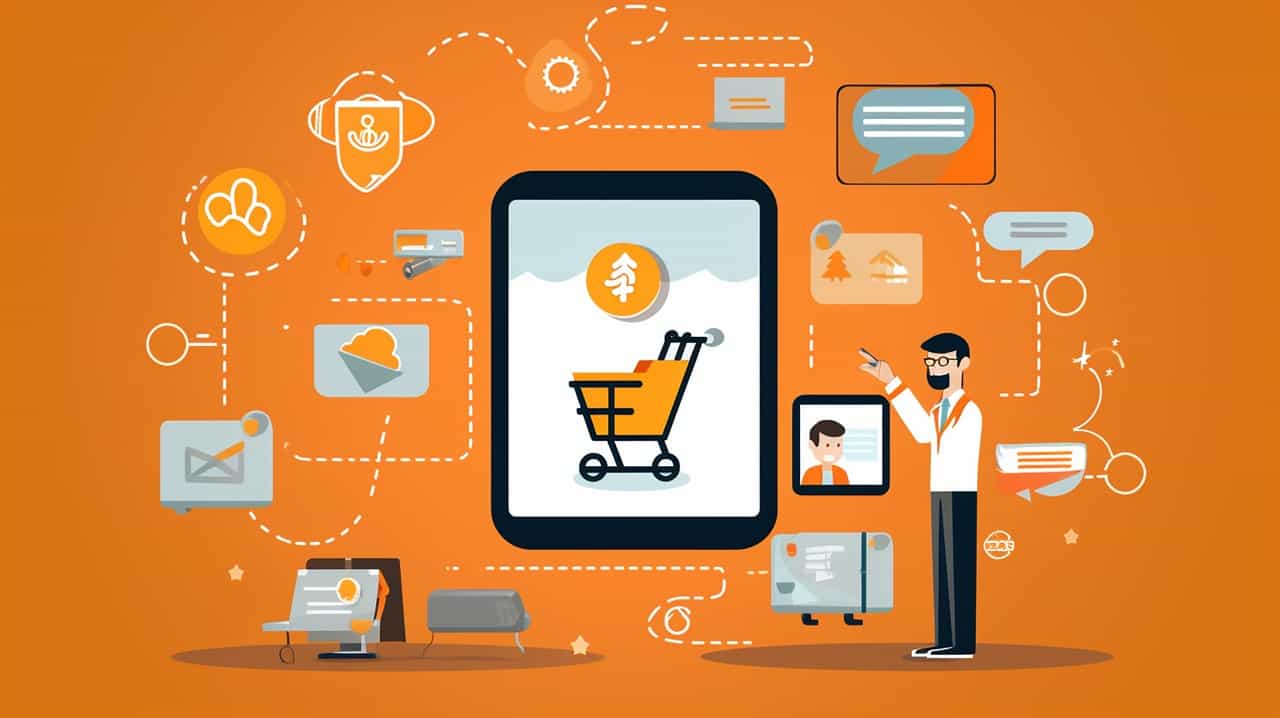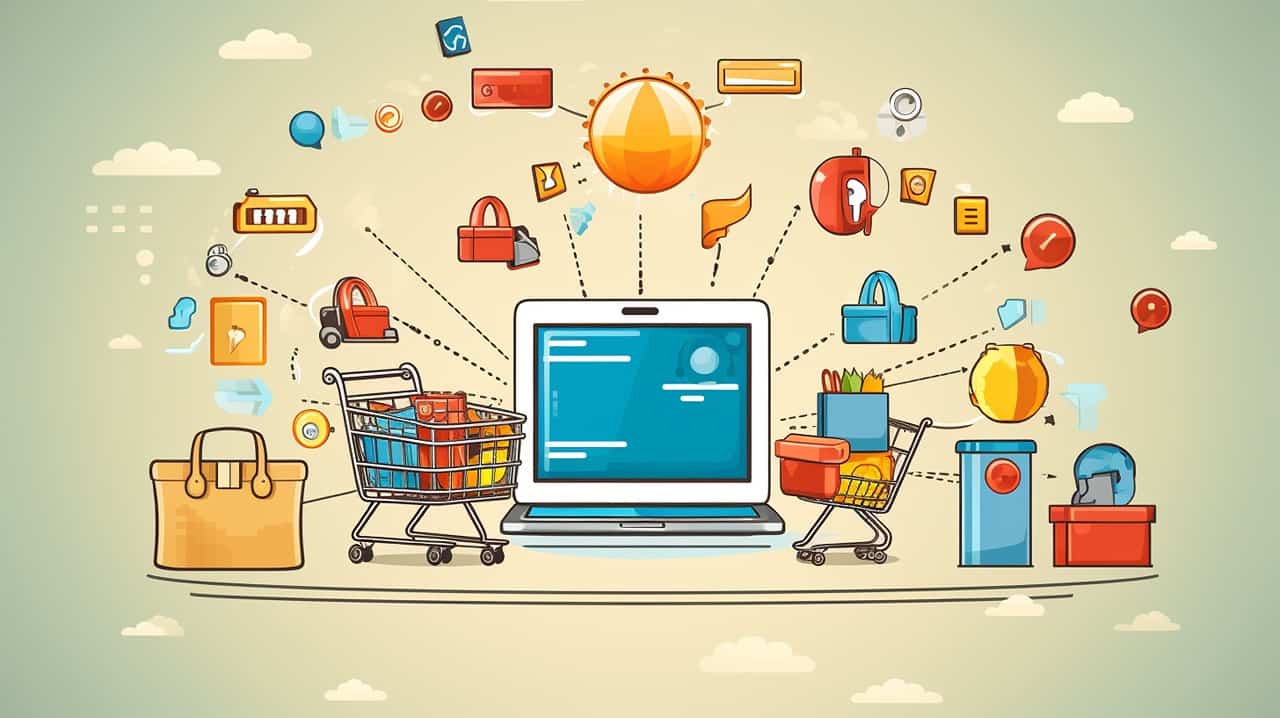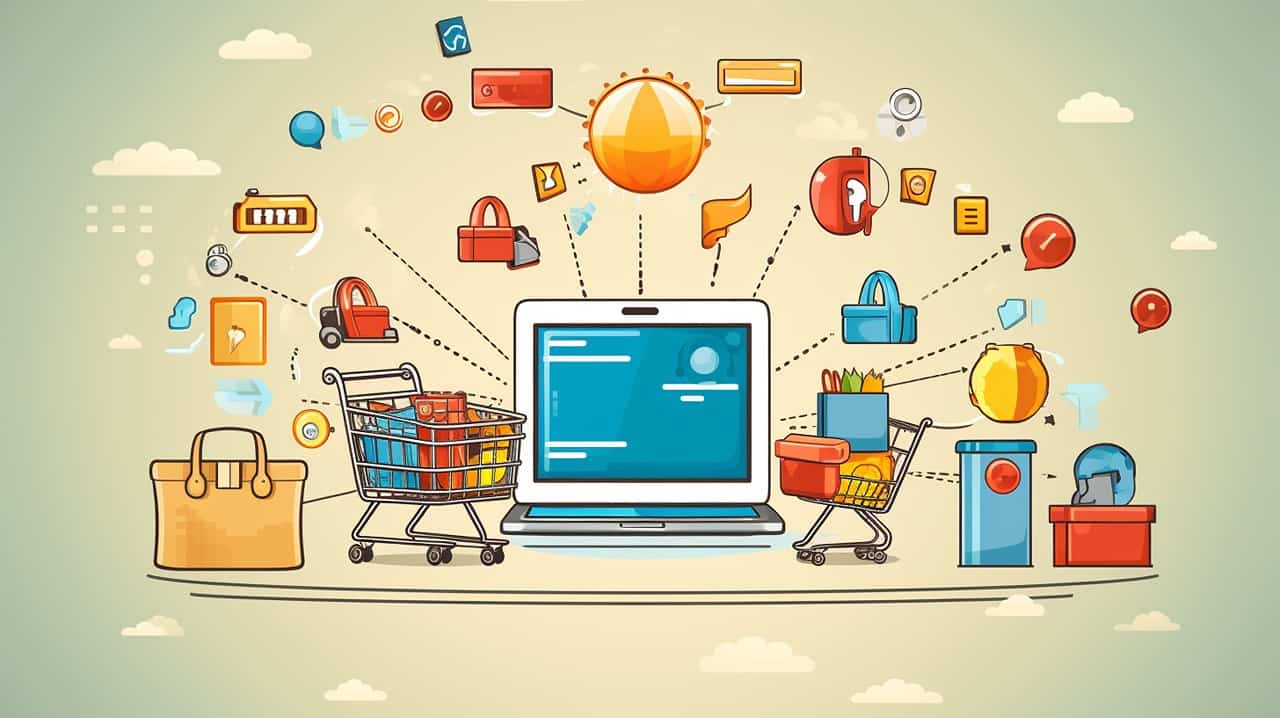Venturing into the digital world with your business is no small feat, and choosing the right platform—whether it’s e-commerce for desktop browsers or mobile commerce for on-the-go shoppers—can feel like navigating a maze.
Trust me, I get it. Understanding the nuances between desktop clicks and mobile taps isn’t exactly a walk in the park. That’s precisely why I rolled up my sleeves and dived into the nitty-gritty of how each option works to figure out which best aligns with different kinds of business goals.
In this piece, we’re going to unpack those insights together so you can make savvy decisions about where to channel your digital energies. Are you ready? Let’s delve in!
Key Takeaways
E-commerce is online shopping from any device, while m-commerce is just on phones or tablets.
M-commerce lets you shop anywhere and often uses your location to give special deals.
Shopping on mobile is super safe with things like fingerprint scans.
Even though e-commerce doesn’t use your location for deals, it still keeps your information safe when you buy things.
Table of Contents
Clarifying E-Commerce and M-Commerce

Let’s get straight into the heart of digital sales, looking at two powerful players—electronic commerce (E-commerce) and mobile commerce (M-Commerce). E-commerce is the umbrella term that captures all online transactions, whether conducted on desktops, laptops, or mobile devices.
It’s like a digital marketplace without walls where consumers can shop from anywhere with an internet connection. On the flip side, M-Commerce zeroes in on transactions executed through mobile apps and websites specifically designed for handheld devices; it puts purchasing power right in your pocket.
Understanding these distinctions isn’t just academic; it’s crucial for business owners who want to meet their customers where they are—which today means everywhere! With each platform offering unique features and catering to different customer habits, knowing how to leverage both E-commerce and M-Commerce can set you ahead in the competitive online retail landscape.
Definition of E-Commerce
E-commerce means people buy and sell things over the internet. It’s like having an online store where folks can shop for what they need from their computer or phone. You might know some big names that do this, like Amazon or eBay.
There are different ways e-commerce happens: sometimes it’s between businesses and customers, other times it’s between two businesses, or even between a business and the government.
This way of shopping makes life easier because you don’t have to leave your house to buy stuff. All you need is an internet connection, a device to go on the web with, and maybe a credit card.
From clothes and books to groceries – almost anything can be bought through electronic commerce today!
Definition of M-Commerce
M-commerce stands for mobile commerce or mobile ecommerence, and it’s all about buying and selling goods through mobile devices like phones or tablets. Picture yourself using your phone to buy a pair of sneakers; that’s m-commerce in action.
It covers everything from shopping online, booking a ride, to managing money with mobile banking. And guess what? Back in 2017, people bought over one-third of their stuff on m-commerce in the US alone.
By 2021, it jumped up even higher.
This isn’t just ordinary shopping; there are cool features too! You can use things like face recognition or your fingerprint to make sure nobody but you buys anything with your device.
This keeps your money safe while making shopping super easy wherever you may be — no need for cash or cards!
Mobility: The Defining Difference

The game-changer between e-commerce and m-commerce lies in mobility, where m-commerce excels by offering unparalleled accessibility. Customers can engage with mobile commerce anytime, anywhere, simply through their smartphones—transforming mundane moments into shopping opportunities.
On the other hand, e-commerce platforms typically require a desktop or laptop, tethering users to specific locations for online shopping sessions. This distinction elevates m-commerce as the epitome of convenience in our fast-paced world.
Accessibility of M-Commerce
I love how mobile commerce breaks down barriers. You can shop from your phone anytime, whether you’re on a bus or taking a lunch break. This freedom is amazing for customers and opens up so many doors for us as business owners, too! We don’t need to worry about setting up shop in one place because our store goes wherever our customers go.
Digital wallets like Apple Pay and Google Pay make buying things with a mobile phone super quick and safe. No more digging around for credit cards or cash – just a few taps on the screen, and it’s paid! Mobile shopping is not only handy but also smart.
It understands what customers like by keeping an eye on their choices, which helps me offer them exactly what they want the next time they visit my online store.
Flexibility of E-Commerce Platforms
E-commerce platforms let you reach customers everywhere. They are not just for computers; they also work well on mobile phones and tablets. This means people can shop from your store using any device they have.
That’s super handy because everyone has their favorite way to go online.
These platforms change size to fit all screens, making shopping easy for everyone. If someone wants to buy something from their phone or tablet, everything looks good and works right.
You don’t lose sales because your site is hard to use on a small screen! Plus, being able to shop anytime and anywhere helps you sell more things. So, having a flexible e-commerce website is really important if you want your business to do well online.
User Experience and Interface

Delving into the realm of User Experience and Interface, we recognize that m-commerce apps tend to prioritize simplicity and streamlined navigation. They’re built with the mobile user’s need for speed and efficiency in mind.
On the flip side, e-commerce websites provide a more comprehensive browsing experience, offering detailed product information and comparisons that are easier to navigate on larger screens, such as those of laptops or desktops.
It’s about matching the platform to the user’s journey; while an m-commerce app might offer a quick checkout process for on-the-go shoppers, an e-commerce site could afford them the luxury of leisurely perusing through extensive catalogs online.
The Simplicity of M-Commerce Apps
I love how mCommerce apps make shopping so easy for people on the go. They are made to be simple and quick to use. A good example is how you can buy something from a store like Amazon right from your phone.
You don’t need a big computer screen; it’s all about tapping the app, finding what you want, and buying it fast.
These apps often have cool security, too, like using your fingerprint or face to make sure it’s really you. This means you can feel safe when you’re buying stuff with your phone. Mobile commerce is just handy and smart, especially if I’m busy and need to shop without stopping my day.
The Comprehensive Nature of E-Commerce Websites
E-commerce websites are like big online stores. They let you sell many things to lots of people all at once. Think of them as a one-stop-shop on the internet where customers can find everything they need.
These sites work on computers, like desktops and laptops, but also look good on phones and tablets.
They have lots of tools for business owners, too. You can track what people buy, suggest items they might like, and see how your store is doing anytime. Places like Shopify make it easy for businesses to set up their online shop and start selling fast.
With e-commerce websites, the whole world is your market!
Location Tracking and Personalization

In the world of M-Commerce, location tracking stands as a game-changer. With this technology, businesses tap into proximity marketing, offering customers personalized recommendations and deals based on their real-time whereabouts.
E-commerce can’t quite match this level of customization since it lacks the ability to interact with the consumer’s immediate environment. This difference highlights a unique advantage for mobile platforms – tailoring experiences that feel individualized and contextually relevant to each user.
As I immerse in the digital commerce landscape, I’ve seen firsthand how powerful these targeted strategies can be in enhancing customer engagement and loyalty.
Location-Based Services in M-Commerce
I love how mobile commerce, or m-commerce, brings shopping right to your phone. With location-based services, my business can send you special deals just when you’re nearby. Think of it like a personal shopper in your pocket! These services use GPS and WiFi to figure out where you are.
Then, they show ads and offers that match what’s close to you.
Imagine getting a coupon for your favorite coffee shop just as you walk by it – that’s the power of personalized recommendations through m-commerce. I get to learn about my customers, too – stuff like where they’re from and what they like.
This helps me make their shopping experience feel unique and just for them. It turns a regular old shopping trip into something extra special!
Lack of Proximity Marketing in E-Commerce
E-commerce often misses out on using proximity marketing. This means online stores can’t send deals or show products that match where you are. For example, if you walk by a store in real life, your phone might get an alert for a sale inside.
But when shopping online at home, this doesn’t happen because the website doesn’t know where you’re at.
This can be tough for business owners like us who want to give people special offers based on their location. We’d have to change how websites track shoppers without getting too nosy.
That way, we could suggest things they might like and are close enough to buy right away.
Security Concerns and Measures
In the digital commerce landscape, security remains a top priority for both consumers and businesses. As we shift toward mobile platforms, m-commerce brings enhanced security protocols into play; features like biometric authentication are becoming standard in app development to protect users from threats such as credit card fraud.
On the flip side, e-commerce platforms often stick with traditional approaches, relying on Secure Sockets Layer (SSL) certificates and robust encryption methods to safeguard transactions.
However, it’s crucial for online retailers to stay vigilant as cyber threats evolve—implementing regular updates and educating customers about secure practices can help maintain trust and ensure a safe shopping environment across both e-commerce and m-commerce channels.
Enhanced Security Protocols in M-Commerce
I make sure my mobile store is extra safe for customers. We use special ways to check who’s buying, like fingerprints or face scans. This helps stop credit card fraud and keeps shopping on phones secure.
It’s a bit tricky because there are so many different phones out there, but we work hard to keep every kind of phone safe.
My m-commerce platform takes security seriously because I know people worry about it when they shop with their smartphones and tablets. We update our safety steps often to stay ahead of any sneaky risks that could show up.
This way, customers can trust us more and feel good about buying from my mobile shop anytime, anywhere.
Traditional Security Approaches in E-Commerce
In e-commerce, we have to take care of our online stores just like we look after a physical shop. This means making sure everything is safe and sound for our customers. To do this, e-commerce uses some old-school security tricks that are still very important.
One big method is encryption. That’s when data gets scrambled up so only the right person with the right key can read it.
Another classic move is using firewalls. Think of firewalls like strong walls around a castle, keeping out unwanted visitors from your website. We also work hard to stay PCI DSS compliant – that’s a set of rules to make sure credit card info stays safe.
We know hackers are clever; they always look for ways to get in. So we must keep updating our security tools and stay on guard all the time because safety matters both in e-commerce and mobile commerce – no one wants their money or personal details stolen!
Marketing and Engagement
In the realm of mobile commerce, marketers have found a goldmine in push notifications, capturing customer attention right where they spend their time – on their phones. Meanwhile, e-commerce isn’t left behind; it harnesses the power of SEO and well-crafted email campaigns to attract and retain customers.
Both avenues offer brand touchpoints but cater to different consumer behaviors: m-commerce seeks immediacy with alerts that pop up in real time, whereas e-commerce builds a story through thoughtful emails that land in your inbox.
Whether it’s an SMS marketing blitz or the strategic use of social media ads, these platforms understand how pivotal engagement is for fostering customer loyalty and driving sales.
Push Notifications in M-Commerce
I love how push notifications give me the power to talk to customers right on their phones. It’s like sending a friendly tap on the shoulder, except it’s through their screen. These little messages pop up and can tell them about a big sale or remind them they left something in their cart.
It’s great for keeping my brand at the top of their minds without being too pushy.
My m-commerce shop uses these notifications wisely. They’re not just for ads; I send out useful info, too. Think about weather alerts that suggest buying an umbrella from my store or quick tips related to products they’ve bought before.
This way, I build trust with my customers, and that can turn into more sales down the road. Using mobile payment systems makes it easy for them to buy right then and there, which is awesome for business!
Email Campaigns and SEO in E-Commerce
Email campaigns are a powerful tool for talking to customers and keeping them coming back. They let you send special deals and new product news straight to your customer’s inbox. This way, you make sure they think of your store when they’re ready to buy something.
And with good search engine optimization (SEO), your online store shows up higher in Google searches. That means more people click on your website when they’re looking for things to buy.
SEO makes it easy for shoppers to find you anytime they need what you sell. It’s like putting up a big sign that says, “Come on in!” People see it, come visit, and might buy from you instead of someone else.
With strong SEO, the internet helps more people discover all the great stuff at your shop without them having to search hard for it.
Payment Options and Processes
In the realm of digital shopping, payment methods are a critical crossroads where convenience meets necessity. E-commerce platforms pride themselves on offering a plethora of payment gateways, ranging from credit and debit cards to PayPal and other online services, ensuring that no matter the shopper’s preference, there’s an option available.
On the flip side, M-Commerce steps up the game with mobile wallets like Apple Pay or Google Wallet, simplifying transactions down to a single tap or scan. The in-app purchase feature is particularly noteworthy; it streamlines buying processes further within mobile applications, making spontaneous purchases almost effortlessly seamless for users on the go.
This simplicity can boost impulse buys and enhance overall customer satisfaction by minimizing transaction friction – key considerations for any business owner looking to refine their digital sales strategy.
Mobile Wallets and In-App Purchases
Mobile wallets make shopping easy for you and your customers. You can use them anywhere, anytime, with just a few taps on your phone. They’re great for mobile commerce because they let people buy things fast without digging around for cards or cash.
Think of Apple Pay or Google Wallet – these tools keep all payment info safe in one place.
In-app purchases are another cool feature for mobile users. When someone is using an app and decides to buy something, they can do it right there without leaving the app. This is super handy and keeps the shopping smooth and simple.
Mobile payments like this are changing the way we shop, making it quicker than ever to grab what we want online!
Diverse Payment Gateways in E-Commerce
I know how important it is for my e-commerce store to offer different payment methods. My customers love having choices, and that’s why I include credit cards, digital wallets like PayPal, and online banking options at checkout.
It makes buying things from me easy and safe for everyone.
Adding lots of payment gateways means more people can buy from my shop. Someone might prefer using their smartphone app to send money, while another person likes typing in their card details on a laptop.
With these choices, I make sure no customer walks away just because they couldn’t pay the way they wanted. It’s all about making shopping smooth and stress-free!
The Omni-Channel Approach
In today’s fast-paced market, an omni-channel approach is not just a nice-to-have; it’s essential for staying competitive. Customers expect seamless integration across all platforms, whether they are browsing on their mobile phones or clicking through a website on their laptops.
M-commerce excels in this arena with its inherent design for cross-device compatibility, enabling users to switch between devices without losing track of their shopping cart or wishlist items.
E-commerce, traditionally focused on desktop experiences, is now recognizing the importance of a unified customer journey and is adapting by offering responsive designs that maintain functionality and brand experience across various devices.
This shift towards an inclusive digital presence ensures that no matter the touchpoint, your business remains consistently at the fingertips of your customers—ready to engage them wherever they are online.
Integration Across Platforms in M-Commerce
M-Commerce is all about connecting with customers wherever they are, and that means making sure everything works together smoothly. I make sure my mobile store feels the same no matter if customers shop from their phone, tablet, or even a smartwatch.
The goal is to give them a super easy shopping experience on every device they use.
As a business owner like you, I’ve seen how important it is to have my products show up right and work well across different platforms. With stuff like Progressive Web Apps (PWA), my mobile commerce can reach more people in better ways.
They can start shopping on one device and finish on another without any hiccups. It’s all about giving our shoppers what they need when they need it – an awesome seamless journey from looking to clicking ‘buy.’
The Singular Focus of E-Commerce Platforms
E-commerce platforms often have one main goal: to sell products and services online. These websites are made to handle loads of information and give shoppers lots of choices. You can find almost anything on an e-commerce site, from books to clothes to gadgets.
They work well on laptops and desktop computers, which have bigger screens.
These platforms let businesses reach people all over the world. This means a small shop can sell things far away without having a physical store there. E-commerce sites need good internet connectivity so everything runs smoothly for customers shopping at home or in the office.
Brands use these sites to learn more about customer behavior and offer tailored experiences, even though they don’t target based on where customers are right then.
Advantages and Disadvantages
M-Commerce scores high on convenience, offering shoppers the ability to purchase from anywhere at any time directly from their smartphones. The rapid growth of mobile technology means consumers can enjoy a seamless shopping experience with features like tap-to-pay or in-app purchases that make transactions effortless.
However, M-Commerce isn’t without its challenges; the reliance on continuous internet connectivity can hinder the shopping experience in areas with poor service.
On the flip side, E-Commerce boasts an extensive reach as it’s accessible through various devices such as desktops and laptops, presenting online retail stores with opportunities to engage broader audiences.
E-commerce retailers harness robust payment gateways that cater to diverse customer preferences but must contend with increasing security concerns that necessitate constant vigilance and updates to protect consumer data.
Business owners need to weigh these factors carefully—the mobility and user-centered design of M-Commerce platforms versus the broad accessibility and established infrastructure of traditional E-Commerce sites—to determine what best aligns with
The Convenience of M-Commerce
M-commerce makes shopping super simple for customers. They can use their phones to buy things at any time, no matter where they are. This is great because people carry their phones everywhere.
With mobile apps, shops talk directly to shoppers through messages that pop up on the phone screen. These messages tell buyers about deals or new items.
I love how m-commerce platforms change shape to fit any phone screen perfectly. This means customers have a smooth and easy time looking at products and buying them right from their hands.
Paying is also a breeze with options like Apple Pay or Android Pay – just a few taps and it’s done! Business owners shouldn’t miss out; connecting with customers through their phones is the smart way to go.
The Broad Reach of E-Commerce
E-commerce lets you reach customers everywhere. If I sell online, someone with Internet access and a laptop can find my store. That’s powerful! It doesn’t matter if they’re in a city office or cozy at home; they can shop from me.
This kind of online selling connects businesses to buyers across the globe.
My business could be just me with a computer, but through e-commerce, I can act big. Thanks to the web, even small shops get into global markets without needing lots of money for stores in different places.
Online retailing means no limits – anyone who wants what I have is a potential customer, no matter where they are.
The Connectivity Challenges of M-Commerce
I know that being on the go is a big part of our lives, and it’s why mobile commerce can be super handy. But there’s something to watch out for: internet problems. If you’re using your phone and you hit a spot with bad service, or you’re running low on data, this can mess up your shopping experience.
Imagine trying to buy something online, and just as you’re about to pay, everything freezes because the connection drops. It’s frustrating for customers, and it could mean lost sales for businesses.
Also, let me tell you about security – it’s critical in m-commerce. Phones are smart, but they can also be easy targets for hackers who want to steal information or get into accounts without permission.
We’ve all heard stories about data theft; it’s scary stuff! So if I’m running an m-commerce site, making sure everything is safe and secure has got to be top of my list. No one wants their customers worrying about these issues when they’re shopping on their phones.
Security Concerns in E-Commerce
Security worries are big in the e-commerce world. We all have to keep our online stores safe. Hackers try to break into our customer accounts and steal money information. It’s scary, but true.
As a business owner, I must make sure my online shop is like a fortress. I use tough security steps like encryption and secure ways for customers to log in.
Keeping my customers’ trust means protecting their personal stuff always comes first. Every time they buy something from my site, they need to feel safe. So, making sure everything from the shopping cart to check out is locked tight is part of my everyday job.
It’s not just about selling things; it’s about keeping those bad guys away at every step!
The Future of Digital Commerce
Discover emerging trends like AI-driven shopping assistants, AR-enhanced product visualization, and voice commerce that are shaping the future of digital retail. These innovations promise a more interactive and personalized shopping experience, blurring the lines between physical and virtual storefronts.
Stay ahead in the game by embracing these changes coming to e-commerce and m-commerce landscapes. Don’t miss out on learning how these advancements could revolutionize your business!
Trends in M-Commerce: AI, AR, and Voice Shopping
Mobile shopping is getting smarter and more exciting. With new tech like AI, AR, and voice commands, your phone becomes a powerful shopping tool.
- AI Chatbots Make Shopping Smooth: Imagine having a helper in your pocket. AI chatbots in mobile apps can answer questions, suggest products, and even help with problems. This means you can shop or get support at any time without waiting.
- AR Brings Products to Life: Augmented Reality or AR makes it seem like things you want to buy are right there with you. Customers can see how a sofa looks in their living room or how sunglasses fit their face before buying. Making choices gets easier, and returns become fewer.
- Voice Shopping is the New Trend: Speaking to your phone to shop is now a thing. Voice shopping through assistants like Siri, Amazon Alexa, or Google Assistant is growing fast. It’s quick and hands-free, which people love for busy days.
- Personalized Suggestions with AI: Your mobile knows what you like. With AI, apps track what you view or buy and then suggest similar items just for you. It feels special and saves time searching.
- Augmented Reality Checks Fit & Style: No more guessing if something will look good on you. AR lets customers try on clothes via their mobile camera. It’s like a fitting room at home!
- Voice Search Shapes Customer Behavior: Talk to shop? Yes! People use voice search more now for things they want to buy later online. Businesses need to think about this when they pick words for ads or product names.
Innovations in E-Commerce: VR and Advanced Analytics
I want to talk about some cool new things in e-commerce, like VR and smart data use. This stuff is changing the way I sell things online and how people shop.
- Virtual reality (VR) is getting big. It lets customers feel like they’re in a store even when they’re at home. They can look at products from all sides. Imagine someone trying on clothes or seeing how a couch looks in their living room with just a headset!
- Advanced analytics help me understand my shoppers better. I get to see what they like when they buy, and more. This means I can make my store better for them.
- Because of these smart analytics, I can also send folks deals and suggestions that make sense for them. Each customer gets a personal touch.
- Keeping customers happy brings them back. Using data right, I can build loyalty and keep people coming back for more.
- VR isn’t just cool; it makes shopping online easier for my customers. They get to try things out without the hassle of returning items later.
- Thanks to all this fancy tech, I can solve problems before they happen. If I see that a lot of people are leaving my website on one page, I can fix it up so they stay around longer.
Conclusion
In our journey exploring the synergies and distinctions between e-commerce and m-commerce, we’ve uncovered that their complementary roles are shaping the future of digital commerce—offering innovative pathways for entrepreneurs to connect with their customers wherever they may be.
Dive deeper into how these platforms can elevate your business in the full article.
The Complementary Roles of E-Commerce and M-Commerce
E-commerce and m-commerce both have important roles to play in modern shopping. They’re like two sides of the same coin, working together to give customers what they want. While e-commerce lets people shop from their desktops or laptops, m-commerce adds another level by letting them buy things right from their mobile phones.
It’s about giving choices so that everyone can shop how they like.
Think of it this way: a person sitting at home might use a laptop to search for products on an e-commerce website. But the same person could also use a phone to make purchases through an app while out with friends.
This means I can keep my business open for all kinds of shoppers, offering a smooth experience whether they’re at their desks or on the move. And since both e-commerce and m-commerce use secure payment gateways, my customers always feel safe no matter how they choose to shop.
Integrating these platforms is key because it helps me understand my customers better and meet their needs wherever they are.
FAQs
What is the main difference between e-commerce and mobile commerce?
E-commerce means buying or selling things on the internet using devices like laptops, while mobile commerce is specifically using mobiles or tablets to shop online.
Can I only use my phone for mobile commerce?
Yes, you can shop with your phone or other devices like personal digital assistants that fit in your hand and have a mobile operating system.
Is there a special kind of shopping website for phones?
Many e-commerce businesses make a mobile version of their website that works better on phones and helps customers find what they need easily.
How do contactless payments work with mobile commerce?
When you buy something with your phone, you can often pay without touching anything by using contactless payments through apps from places like the Google Play Store.
Are all types of e-commerce available on phones, too?
Most kinds of online shopping, including business-to-business (B2B) marketing and customer-to-customer sales, are possible on both computers and phones.
Does using my phone for shopping offer something special?
Yes! With augmented reality (AR), you can see how things might look in real life right from your phone, which adds fun to your shopping experience.



